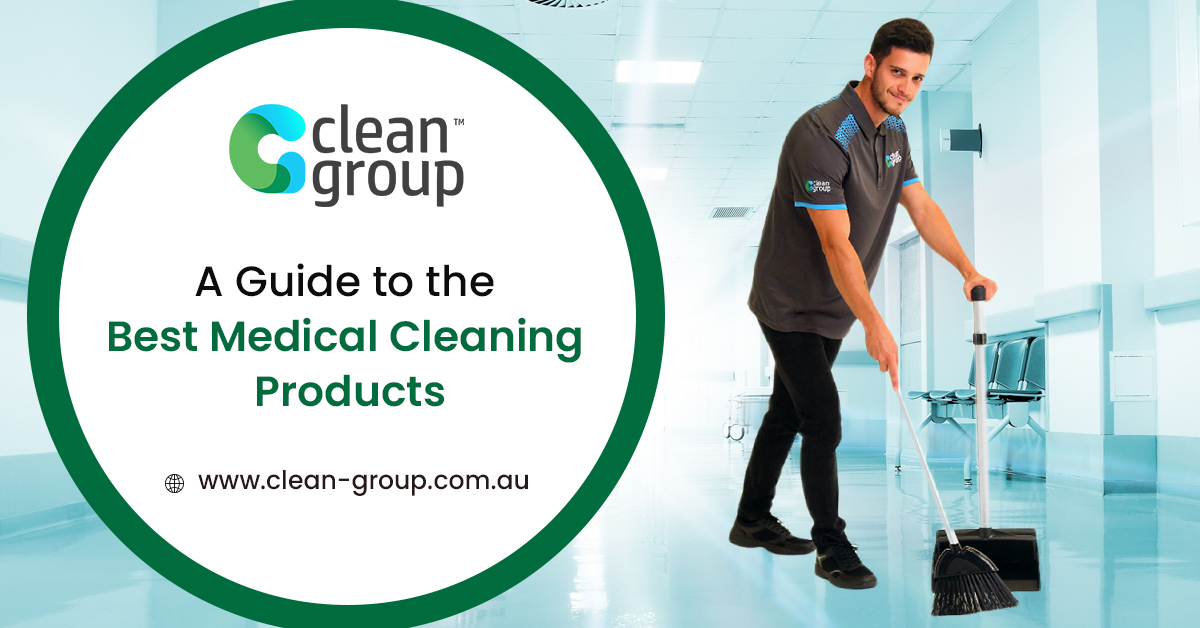As crucial as it is to maintain a high standard of cleanliness in a medical facility like a hospital, it is more important to select and use the best quality hospital-grade cleaning products to ensure maximum efficiency and safety.
Choosing the right cleaning product is important for several reasons. Not only is a low-quality product not good enough to ensure the level of cleanliness and hygiene that you’re looking for, but also it may negatively impact the health & safety of your patients and visitors, which is the last thing you’d expect from a hospital cleaning. There are many things one needs to consider when selecting the right product for their medical cleaning project, including specific requirements & cleaning goals and the advantages & disadvantages of different cleaning chemicals.
Why medical cleaning using the right product is important
Professional cleaning of medical premises using high-quality disinfectants & products can help reduce the hazard of healthcare-associated infections (HAIs), which include infections associated with the use of contaminated medical devices, such as syringes, catheters and ventilators. Some of the common types of HAIs include blood infections, urinary tract infections, and pneumonia.
Specific cleaning products with the correct combination of chemicals for effectiveness against a variety of bacteria, spores, germs, viruses, and microbes must be used for medical centre cleaning. This is crucial for reducing health hazards and ensuring the proper & complete removal of germs from a facility.
The use of appropriate cleaning products, disinfectants, etc. is crucial for the overall cleanliness & hygiene maintenance in medical premises.
Cleaning vs Disinfection vs Sanitizing
Cleaning and disinfecting are two major steps in a medical cleaning process. While cleaning removes any and all visible soil, dirt, and debris from surfaces and objects, disinfecting is intended to kill invisible pathogens, bacteria, viruses & microbes from surfaces, making them both clean and safe.
Sanitising helps reduce the number of germs on a surface, but it may not be able to completely kill or destroy germs. Sanitisers are commonly used for disinfecting food-contact surfaces and areas such as kitchens to reduce the bacteria population to a safe level.
What Cleaning Products Are Required for Medical Facility Cleaning
In a healthcare facility, a broad range of cleaning chemicals and products are used for different cleaning tasks and areas. These include:
- Detergents & Soaps
- Iodophors
- Antiseptic (Hydrogen Peroxide)
- Bleach (Sodium Hypochlorite)
- Alcohols 60-90%
- Aldehydes (for disinfection)
- Hydrogen Peroxide
- Quaternary Ammonium Compounds
- Chlorine
- Phenolic
- Sodium Dichloroisocyanurate
- Calcium Hypochlorite
Not all or other chemicals might be needed depending on the type of your medical facility and your specific cleaning requirements.
Choosing the Right Disinfectant Product for Hospital Cleaning
These days, you cannot ensure the maximum level of cleanliness and hygiene by using any traditional cleaning products. As we are surrounded by many new varieties of pathogens, we need to use high-end disinfectant products that are effective against most, if not all, types of viruses, bacteria, and germs out there.
When buying and using disinfectants for cleaning a medical facility, the key is to look for products that have been registered or approved by a prestigious healthcare authority such as the EPA (Environmental Protection Agency) or TGA (Therapeutic Goods Administration). These cleaning products are extensively tested and found effective against the removal of viruses and germs for sanitation in a hospital.
There is no best disinfectant. The right disinfectant product should be selected based on the individual needs and type of facility and considering factors such as the antimicrobial balance, toxicity of the disinfectant, required disinfection standard, cost of the product, and ease of use.
At Clean Group, we only use TGA-approved disinfectants for cleaning medical facilities and other sensitive premises such as schools and childcare centres. Our chemicals have been tested and found effective against up to 99.99% of common germs and pathogens, including the covid-19 virus.
Things to know when using a Hospital Disinfectant
- Before applying disinfectant, make sure that the surface has been thoroughly cleaned for any visible dirt and debris, or the disinfectant might not work with 100% efficiency
- Use disinfectant only for medical instruments that touch intact skin and are not inserted inside the body
- Make sure to read & follow the manufacturer’s instructions for use of a disinfectant for the best results
- Avoid using a soiled cloth for applying disinfectant, as this might contaminate the solution and reduce its effectiveness
- All cleaners handling, using or applying disinfectants must wear or use appropriate safety gear
- The effectiveness of a particular disinfectant after cleaning should be monitored closely
In addition, we use many of the hospital-grade cleaning chemicals listed above.
Medical Facility Cleaning Products
Detergents & Soaps
Soaps and detergents are commonly used both for cleaning dirt and as a remover of organic matter from surfaces. While soap can loosen dirt, cleaning with soap should include scrubbing and water rinse for proper cleaning of a surface.
Soap is, however, not effective in the removal of microorganisms such as bacteria or mould. Soap is the most popular cleaning product because it is easily accessible and is cheap and can remove all kinds of dirt, dust, organic matter, stains, and grime from various surfaces.
Iodophors
Idophores contain iodine and are antimicrobial in nature. They can be used to kill or reduce bacteria, microbes, and viruses on surfaces. When left on a surface for certain, long periods, they might also be able to kill weak fungi and bacterial spores. It is also used for part preparation before surgery.
Bleach (Sodium Hypochlorite)
Bleach is a powerful but unstable chemical agent that should be used as a last resort. It is corrosive to metals, can discolour fabrics, and can be harmful to the environment and humans due to the release of toxic gas when used with ammonia.
Alcohols 60-90%
The two common types of alcohol used in medical premises are – ethyl alcohol and isopropyl alcohol. These are effective in killing or destroying bacteria, tuberculosis spores, fungi, and viruses. The ideal concentration of alcohol in the disinfectant solution is 60%-90% for the best results.
Alcohol in medical premises can be used for disinfecting both surfaces and objects, including some medical equipment, touch points, etc. and as an antiseptic for preventing the growth & spread of microorganisms. Alcohols, though, are not a suitable solution for sterilising sensitive medical and surgical items.
Aldehydes (for disinfection)
Aldehydes are an excellent high-level disinfectant (HDL) for killing bacteria, viruses, fungi, and spores.
Antiseptic (Hydrogen Peroxide)
Hydrogen Peroxide is effective in removing viruses and is commonly used for disinfecting surfaces and medical equipment. Can be used for the sterilisation of critical medical tools.
Quaternary Ammonium Compounds
Quaternary Ammonium Compounds or QUATs such as Benzalkonium Chloride are generally used for environmental sanitation in non-critical areas and on surfaces such as furniture and floors and for medical equipment disinfection. Quaternaries are not recommended for use as a disinfectant for patient care items, as they might result in infections.
Chlorine
Chlorine and chlorine compounds used in medical premises are antimicrobial, i.e. can be used to kill and reduce microbes on surfaces. Chlorine is the most common compound used in most cleaners & disinfectants because it is cheap, can be used with hard water, does not leave residues, is not toxic, and works fast. It can also remove dried organisms from surfaces.
Phenolic
Phenolics are used in medical settings for cleaning hard surfaces, tiles and walls in toilets and other places and also to disinfect objects such as chairs, beds, etc.
Sodium Dichloroisocyanurate
It is a chlorine compound used for disinfection.
Equipment Used for Medical Cleaning
Other than cleaning products or supplies, equipment or machines used for cleaning should also be selected carefully and based on the particular type and needs of a medical facility. The most common medical cleaning equipment is as follows:
Cleaning trolleys & buckets – A cleaning trolley is standard and comes with spaces to store different equipment such as disinfectant bottles, mops, wipers, etc. Ideally, three buckets should be used for every cleaning round, one for the detergent solution, one for fresh water, and one for disinfectant. Use colour-coded buckets for cleaning different areas of a hospital to avoid cross-contamination.
Wet mops – Color-coded microfiber mops are ideally used for cleaning medical premises by professionals.
Dust mops – for removing dirt and dry dust and debris from critical areas, patient rooms, etc.
Vacuum – For vacuuming general areas, reception, waiting areas, meeting rooms, etc.
Floor wipers – for cleaning hard floors and tiles in toilets, bathrooms, etc. Hand wipers for cleaning kitchen counters, etc.
Dusting brush – to clean equipment and objects, fixtures on the wall, cabinets, etc. Colour-coded mops should be used for different areas.
Dustpans – to collect debris and dirt during cleaning. Dirt should be disposed of immediately. Medical waste should be disposed of in accordance with guidelines.
Cleaning gloves – for cleaners to wear when cleaning sensitive premises or using disinfectants and other cleaning chemicals.
Water – Clean, drinking water should be used both for cleaning and for preparing disinfectant solutions.
What Are the Best Medical Cleaning Products to Buy This Year?
The threat of the covid-19 disease is far from over, which means the hospital cleaning product you are buying or using must have these (listed) active ingredients in order for them to be effective against the coronavirus along with many other viruses and common infections. Here are some of the hospital-grade cleaning & disinfecting products that you can buy for medical cleaning:
- Odour Neutraliser Spray Ecomist
- Viraclean Disinfectant Spray
- Dettol Glen 20
- Dettol Disinfectant
- Milton Antibacterial Solution
- Milton Tablets
- Isopropyl Alcohol
- Instrument Detergent Clinidet
- Floor Cleaner Neutralex
- Infectious Body Fluid Sachet
These are only a few ideas of the type of cleaning products you can buy and use for medical cleaning. These are not recommendations. The key is to find and use products that have TGA-approved ingredients proven effective against common viruses and infections.
If you want to know more, need help choosing the right cleaning products, or want to hire professional cleaners for medical cleaning, contact Clean Group right away. We are a commercial cleaning agency with extensive experience in cleaning & disinfecting medical facilities.
We provide cleaning services to hospitals, clinics, dentists, medical laboratories, pharmacies, research centres, childcare facilities & many more. Contact us today for a free quote.

